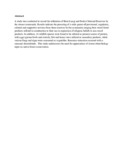| dc.identifier.citation | Waswala-Olewe, B., Andanje, S. A., Nyangit, M. M., Njoka, J. T., Mutahi, S., Abae, R., & Amin, R. (2015). Natural resources utilization by the Aweer in Bonilungi and Dodori national reserves, Kenya. Tanzania Journal of Forestry and Nature Conservation, 83(2), 28-43. | en_US |
| dc.description.abstract | A study was conducted to record the utilization of Boni-Lungi and Dodori National Reserves by the Aweer community. Results indicate the procuring of a wide gamut of provisional, regulatory, cultural and supportive services from these reserves by the community ranging from wood forest products utilized in construction to their use in expression of religious beliefs to non-wood products. In addition, 16 wildlife species were found to be utilized as primary source of protein, with eggs (guinea fowls and ostrich), fish and honey were utilized as secondary products, while various fungi and algae were consumed as vegetables. Resource extraction occurred with a seasonal dissimilitude. This study underscores the need for appreciation of Aweer ethnobiology input on native forest conservation. | en_US |

